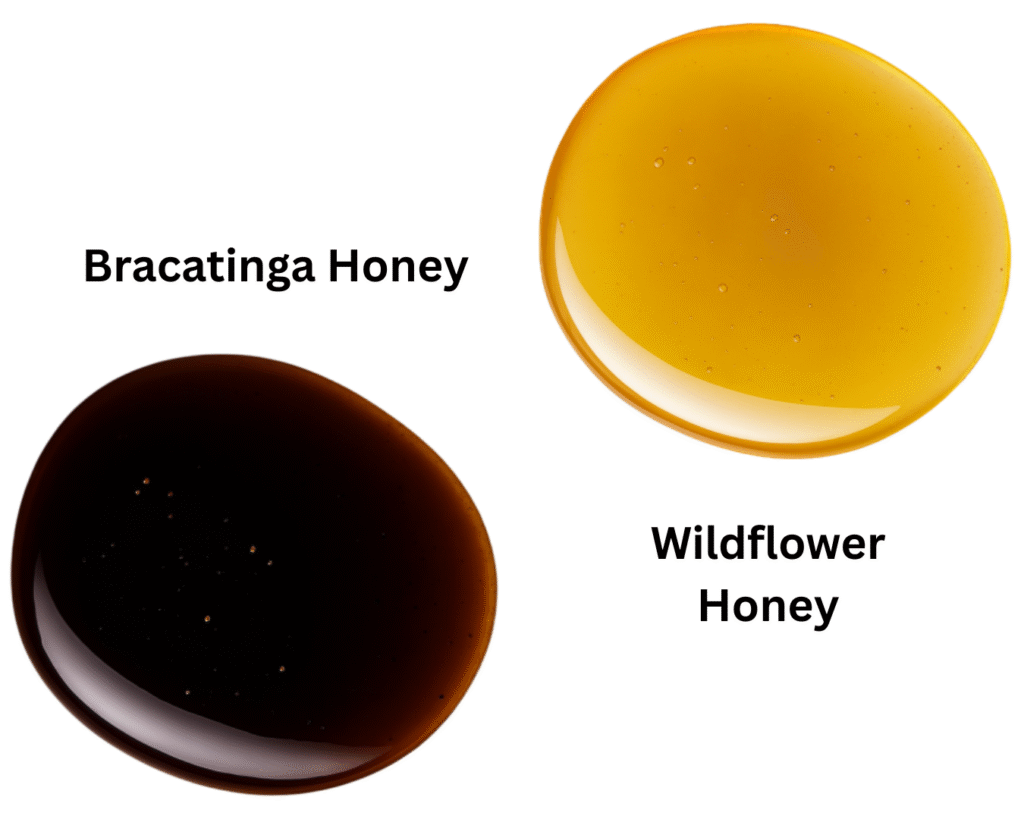
Bracatinga honey offers a mild, floral taste from Mimosa scabrella nectar, while wildflower honey presents a complex, variable flavor from diverse blossoms, both providing unique nutritional benefits and versatile uses in cooking and home remedies.
Have you ever wondered how bracatinga honey vs wildflower honey stacks up in taste and benefits? These two types of honey offer distinct flavors and uses that might surprise you. Let’s dive into what makes each special and how you can pick the right one for your needs.
Origins and botanical sources of Bracatinga honey
Bracatinga honey originates from the South Brazilian Plateau, encompassing areas in Santa Catarina, Paraná, and Rio Grande do Sul [1]. Its botanical source is the Bracatinga tree (Mimosa scabrella), but unlike floral honey, it is produced from the “melato” (honeydew) excreted by scale insects (Stigmacoccus paranaenses) that feed on the sap of these trees.
Botanical origin
The botanical origin of Bracatinga honey is the Bracatinga tree (Mimosa scabrella). However, it’s important to note that the honey itself is not directly from the tree’s nectar but rather from the “melato” (honeydew) excreted by scale insects that feed on the tree’s sap.
Habitat and environment
The habitat and environment for Bracatinga honey production are specifically the Araucaria Forests within the South Brazilian Plateau, particularly in higher altitude regions.
Key environmental characteristics include:
- Geographical Location: The Planalto Sul Brasileiro (South Brazilian Plateau), encompassing areas in Santa Catarina, Paraná, and Rio Grande do Sul.
- Altitude: The Bracatinga tree, which is central to this honey’s production, preferably occurs in altitudes above 700 meters.
- Climate: The predominant climate in the Bracatinga’s occurrence region is classified as Cfb (Koeppen), described as temperate rainy and constantly humid. In the Holdridge system, it’s considered submontane humid or super-humid. The average annual precipitation ranges between 1,300 and 2,500 mm, with uniform distribution throughout the year or a slight reduction in winter, but without water deficits.
- Vegetation: The primary vegetation includes Campos with Capões, Riparian Forests and Pine Woods, Nebular Forest of the Serra Geral Ridge, and most importantly, the Araucaria Forest (or Mixed Ombrophilous Forest). The Bracatinga tree (Mimosa scabrella) is a pioneer species that thrives in these forests, often forming dense stands (bracatingais) after human disturbance.
- Specific Phenomenon: The “melato” phenomenon, where scale insects (Stigmacoccus paranaenses) excrete sugary liquid from the Bracatinga tree’s sap, is restricted to this territory, requiring this specific combination of altitude, climate, and forest conditions.
The emphasis that the existence of Bracatinga honey is intimately linked to the maintenance of these Araucaria Forests and their natural regeneration processes, which are currently under pressure from human activities such as logging, cattle ranching, reforestation with exotic species, and fruit cultivation.
What makes wildflower honey unique
Wildflower honey is unique because it’s made from the nectar of multiple wildflower species, giving it a complex, ever-changing flavor profile that reflects the local flora and season. Its polyfloral origin also contributes to a diverse nutrient composition, including antioxidants and enzymes, making it both flavorful and functional.
Flavor diversity and aroma
The unique aspect of wildflower honey lies in its rich and ever-changing flavor profile. It may range from sweet and floral to slightly spicy or fruity, reflecting the different blossoms bees visit. This makes each batch of wildflower honey distinct and capable of surprising even the most experienced honey lovers.
Nutritional benefits
Because wildflower honey contains nectar from a variety of plants, it often offers a broader range of antioxidants, vitamins, and minerals. These natural compounds contribute to its potential health benefits, such as boosting immunity and providing energy.
Natural variability and sourcing
Wildflower honey’s characteristics depend heavily on the local ecosystem and the time of year it’s collected. Beekeepers often harvest this honey from hives located near meadows, forests, or gardens where many wildflowers bloom. This natural variability makes it a prized choice for those who appreciate artisanal and regionally unique products.
Taste Profiles Compared: Bracatinga vs Wildflower
Bracatinga honeydew honey and wildflower honey offer distinctly different taste experiences rooted in their unique sources. Bracatinga, derived from the secretions of insects feeding on the Bracatinga tree, has a rich, woody flavor with earthy, resinous notes and a slightly smoky finish. Its dark color and thick texture make it ideal for pairing with robust foods like aged cheeses or roasted meats. In contrast, wildflower honey is made from the nectar of various seasonal blooms, resulting in a sweet, floral, and often complex flavor that can include hints of citrus, herbs, or caramel. Its golden hue and medium viscosity make it a versatile choice for teas, baking, and raw applications. While Bracatinga evokes the depth of forest ecosystems, wildflower honey reflects the vibrant diversity of open meadows.
Wildflower honey flavor characteristics
In contrast, wildflower honey offers a more complex and variable taste. Depending on the combination of flowers bees visit, it can range from fruity and sweet to a bit tangy or even spicy. This variety creates a dynamic flavor experience that can change from season to season and location to location.
Texture and color differences
Both honeys typically have a smooth texture, but bracatinga honey usually has a lighter amber color while wildflower honey can vary from light gold to darker amber shades. These visual differences give cues to their distinct flavor profiles.
Understanding these differences helps consumers choose honey that best suits their palate or culinary needs, whether they want the gentle sweetness of bracatinga or the rich complexity of wildflower honey.
Health Benefits and Nutritional Differences
Bracatinga honey and wildflower honey each offer unique nutritional benefits due to their different floral sources. Both types are rich in natural sugars, enzymes, and antioxidants that help support overall health. However, their specific nutrient profiles can vary.
Antioxidants and Vitamins
Bracatinga honey contains antioxidants that help combat free radicals and reduce oxidative stress. It also provides small amounts of vitamins such as B-complex and vitamin C, contributing to immune support. Wildflower honey is often richer in diverse antioxidants and flavonoids since it comes from various flower types, potentially offering broader protective effects.
Mineral Content
Both honeys supply essential minerals like calcium, potassium, and magnesium. Wildflower honey may contain slightly higher mineral diversity due to its mixed nectar sources, which could enhance bone health and electrolyte balance.
Other Health Properties
Both types possess antimicrobial and anti-inflammatory properties, making them popular for soothing sore throats and aiding digestion. The unique enzymes found in each honey can also promote gut health and accelerate wound healing.
Choosing between bracatinga and wildflower honey may depend on your preference for specific health benefits, but both offer natural nutritional advantages when included in a balanced diet.
Common Uses in Cooking and Home Remedies
Bracatinga honey and wildflower honey are versatile ingredients commonly used in cooking and home remedies. Their unique flavors can enhance a variety of dishes, from baked goods to salad dressings, adding natural sweetness and subtle floral notes.
Cooking with Bracatinga Honey
Due to its mild and smooth taste, bracatinga honey works well as a sweetener in teas, marinades, and sauces. It pairs nicely with cheese and fruit, making it a popular choice for gourmet recipes.
Cooking with Wildflower Honey
Wildflower honey’s more complex flavor can enrich recipes requiring a richer sweetness. It complements baked goods, yogurt, and oatmeal, and can be drizzled over pancakes or used in glazes for meats and vegetables.
Home Remedy Uses
Both honeys possess antimicrobial and soothing properties, making them effective natural remedies for sore throats and coughs. They also aid in digestion and can be applied topically to minor wounds and burns to promote healing.
Incorporating these honeys into daily routines offers natural benefits beyond taste, supporting health with their nourishing qualities.
Sustainability and Production Methods
Sustainability in honey production focuses on protecting the environment and supporting bee populations. Both Bracatinga and wildflower honey are products of natural ecosystems, but sustainable practices ensure these resources last for future generations.
Eco-Friendly Beekeeping
Beekeepers practicing sustainable methods avoid harmful chemicals and pesticides that can damage bee colonies. They also promote hive health by providing natural habitats and maintaining biodiversity around apiaries.
Responsible Harvesting
Harvesting honey sustainably means taking only a portion of the hive’s honey, ensuring that bees have enough reserves to survive and thrive. This careful balance helps maintain strong colonies and supports pollination in surrounding environments.
Impact on Ecosystems
Both types of honey benefit from well-preserved natural areas. Bracatinga trees and wildflowers require healthy soils and clean air, so sustainable production encourages conservation efforts for forests and meadows.
By using environmentally conscious techniques, producers of Bracatinga and wildflower honey contribute to the health of bees and the broader ecosystem, fostering a cycle of growth and renewal.
How to Choose the Best Honey for you
Choosing the best honey depends on your taste preferences and intended use. Bracatinga honey offers a mild, floral sweetness perfect for those who prefer gentle flavors, while wildflower honey provides a more complex and varied taste.
Consider Flavor Profile
If you enjoy subtle, smooth honey, bracatinga might be the right choice. For a richer, more robust flavor that changes with the season, wildflower honey is ideal.
Think about Health Benefits
Both honeys offer nutritional and health benefits, but wildflower honey may provide a wider range of antioxidants due to its diverse floral sources.
Check the Source and Quality
Look for honey that is locally sourced and minimally processed to ensure purity. Certified organic or raw honeys often retain more nutrients and beneficial enzymes.
Intended use matters
For cooking and baking, choose a honey that complements your recipes. Bracatinga is great for delicate dishes, while wildflower honey can enhance bold flavors.
Ultimately, experimenting with both types can help you find the perfect honey that matches your palate and lifestyle.
Choosing the right honey for you
Both Bracatinga honey and wildflower honey offer unique flavors and health benefits that can enhance your daily life. Understanding their differences helps you make a choice that fits your taste and needs.
Whether you prefer the mild sweetness of Bracatinga or the rich complexity of wildflower honey, incorporating high-quality, natural honey into your diet can provide nutritional value and enjoyment.
Experimenting with both types over time can help you discover which honey best suits your palate and lifestyle.
FAQ – Bracatinga Honey vs Wildflower Honey
What is Bracatinga honey?
Bracatinga honey is made from the nectar of the Mimosa scabrella tree, known for its light amber color and mild, floral taste.
How does wildflower honey differ from Bracatinga honey?
Wildflower honey is made from nectar collected from many types of flowers, giving it a complex and varied flavor that changes with the season and location.
Which honey is healthier, Bracatinga or wildflower?
Both honeys have health benefits, but wildflower honey may contain a broader range of antioxidants due to its diverse floral sources.
Can I use both types of honey for cooking?
Yes, Bracatinga honey works well in delicate dishes, while wildflower honey enhances bold flavors in baked goods and sauces.
Are Bracatinga and wildflower honey sustainably produced?
Sustainable beekeeping practices support the production of both, focusing on protecting bee health and conserving natural habitats.
How do I choose the best honey for me?
Consider your taste preferences and intended use. Try both to discover which flavor and benefits suit your palate and lifestyle best.


